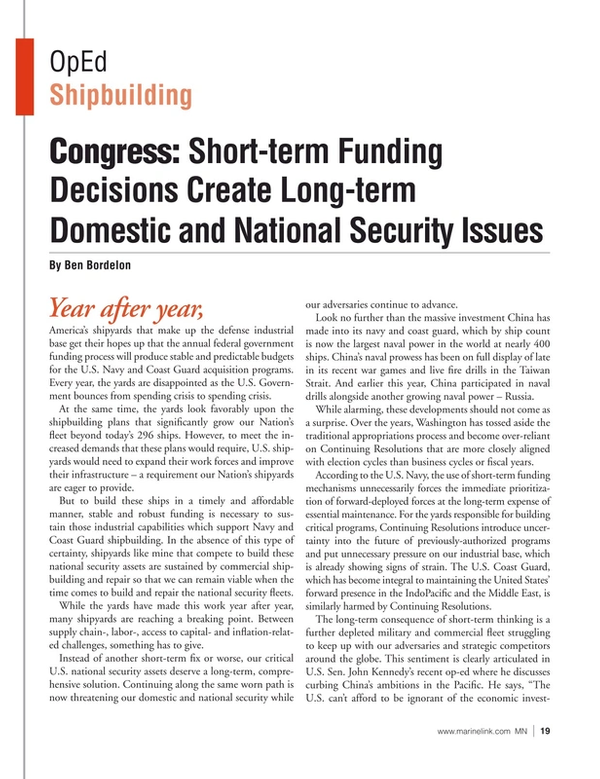
Congress: Short-term Funding Decisions Create Long-term Domestic and National Security Issues
Year after year, America’s shipyards that make up the defense industrial base get their hopes up that the annual federal government funding process will produce stable and predictable budgets for the U.S. Navy and Coast Guard acquisition programs. Every year, the yards are disappointed as the U.S. Government bounces from spending crisis to spending crisis.
At the same time, the yards look favorably upon the shipbuilding plans that significantly grow our Nation’s fleet beyond today’s 296 ships. However, to meet the increased demands that these plans would require, U.S. shipyards would need to expand their work forces and improve their infrastructure – a requirement our Nation’s shipyards are eager to provide.
But to build these ships in a timely and affordable manner, stable and robust funding is necessary to sustain those industrial capabilities which support Navy and Coast Guard shipbuilding. In the absence of this type of certainty, shipyards like mine that compete to build these national security assets are sustained by commercial shipbuilding and repair so that we can remain viable when the time comes to build and repair the national security fleets.
While the yards have made this work year after year, many shipyards are reaching a breaking point. Between supply chain-, labor-, access to capital- and inflation-related challenges, something has to give.
Instead of another short-term fix or worse, our critical U.S. national security assets deserve a long-term, comprehensive solution. Continuing along the same worn path is now threatening our domestic and national security while our adversaries continue to advance.
Look no further than the massive investment China has made into its navy and coast guard, which by ship count is now the largest naval power in the world at nearly 400 ships. China’s naval prowess has been on full display of late in its recent war games and live fire drills in the Taiwan Strait. And earlier this year, China participated in naval drills alongside another growing naval power – Russia.
While alarming, these developments should not come as a surprise. Over the years, Washington has tossed aside the traditional appropriations process and become over-reliant on Continuing Resolutions that are more closely aligned with election cycles than business cycles or fiscal years.
According to the U.S. Navy, the use of short-term funding mechanisms unnecessarily forces the immediate prioritization of forward-deployed forces at the long-term expense of essential maintenance. For the yards responsible for building critical programs, Continuing Resolutions introduce uncertainty into the future of previously-authorized programs and put unnecessary pressure on our industrial base, which is already showing signs of strain. The U.S. Coast Guard, which has become integral to maintaining the United States’ forward presence in the IndoPacific and the Middle East, is similarly harmed by Continuing Resolutions.
The long-term consequence of short-term thinking is a further depleted military and commercial fleet struggling to keep up with our adversaries and strategic competitors around the globe. This sentiment is clearly articulated in U.S. Sen. John Kennedy’s recent op-ed where he discusses curbing China’s ambitions in the Pacific. He says, “The U.S. can’t afford to be ignorant of the economic investments and military overtures China is making to our neighbors in the Pacific.”
China, under the guise of its Belt and Road Initiative, has progressively built a commanding fleet presence, endangering our allies and regional partnerships across Oceana and the Indo Pacific. For example, only five years after an international court ruling that rejected 90% of Beijing's claims in the South China Sea, the presence of Chinese vessels within the Philippines’ Exclusive Economic Zone is more frequent than ever. China has also continued to conduct dangerous military exercises in the Taiwan Strait that risk potential escalation and severely endangers the democratic independence of the nation.
Beijing has spent billions expanding its ports network to secure sea lanes and establish itself as a maritime superpower. Beijing’s shipping lines carry more cargo and deliver more containers than those of any other nation. All told, the South China Sea carries an estimated one-third of global shipping, of which $1.2 trillion accounts from trade with the U.S. And as we have seen from the global supply chain and shipping crisis, China is taking every advantage to fuel its ambitions at the expense of American businesses and consumers.
Meanwhile, the entire U.S. fleet of oceangoing commercial ships numbers fewer than 200 vessels, out of a global total of 44,000. By allowing China to control the waters of the Indo-Pacific, America is ceding its leadership, severely endangering our critical supply chains and threatening our economic security and that of our allies.
The United States must reaffirm its position as the world’s unequivocal maritime superpower. The U.S. shipyard industry and industrial base stand at the ready, annually supporting nearly 400,000 jobs across the United States, producing $28.1 billion in direct labor income and contributing $42.4 billion in direct GDP to the national economy.
As we face these significant challenges ahead, we must start first with stable and predictable government funding processes that are designed to build and maintain our national and domestic security assets and invest in our mariners and industrial base. Budgets need to be designed for decades, not political cycles. Our domestic and national security depend on it.
Read Congress: Short-term Funding Decisions Create Long-term Domestic and National Security Issues in Pdf, Flash or Html5 edition of September 2022 Marine News
Other stories from September 2022 issue
Content
- Roundtable: North American Naval Architects Weigh In page: 12
- Congress: Short-term Funding Decisions Create Long-term Domestic and National Security Issues page: 19
- Marine Group Boat Works: Standing Steady on Four Legs page: 22
- Inland Waterways Report: Columbia-Snake River System page: 32
- Silverback Marine Brings Fresh Blood—and Ideas—to Boatbuilding page: 38


